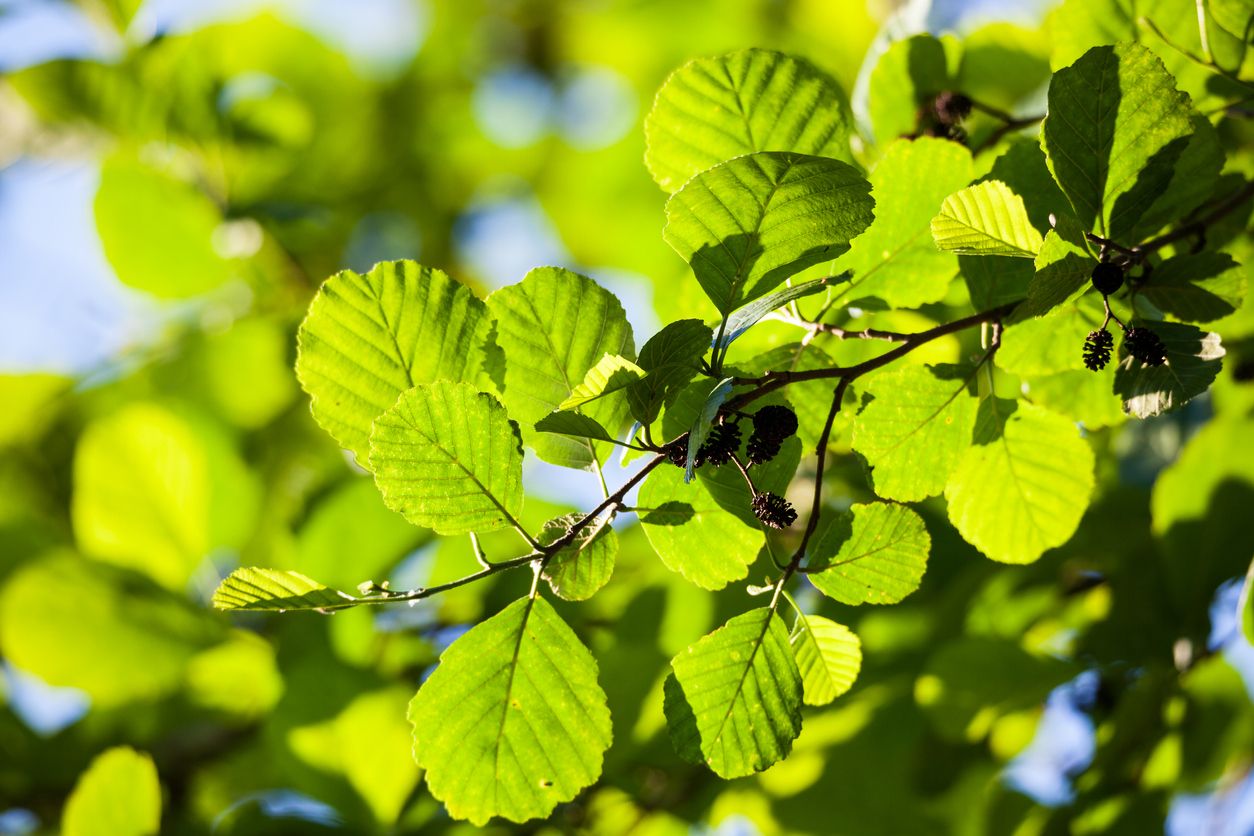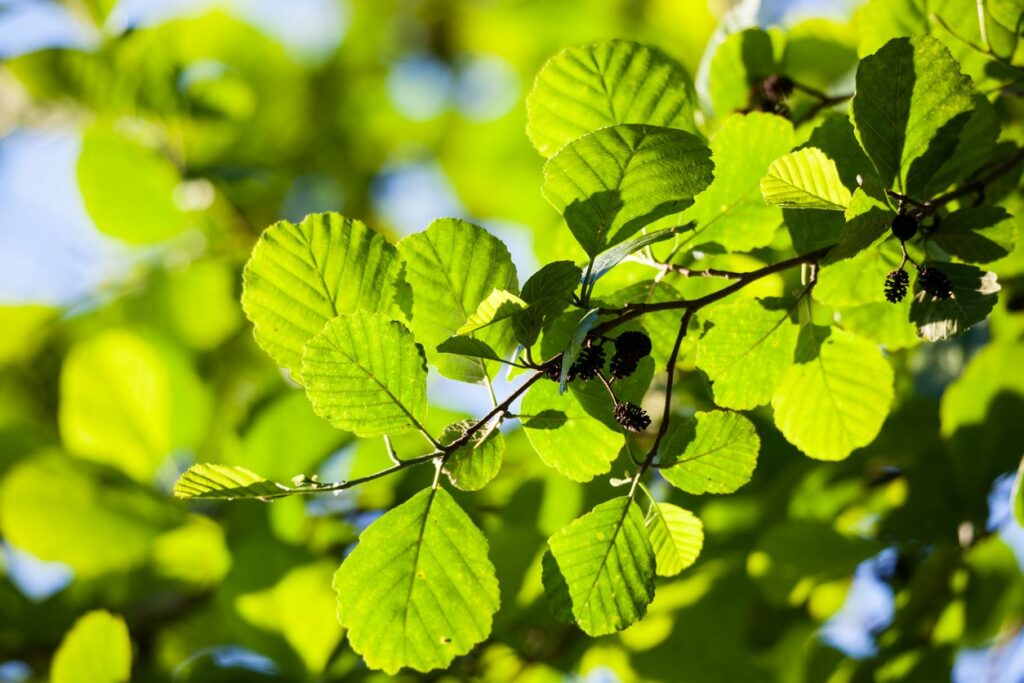The Alder Tree – Identify, Grow, And Care For Alder Trees
Steeped in mythology and folklore, the alder tree is formidable and awe-inspiring any way you look at it. Not the kind of tree too afraid to get its feet wet, the alder has been a permanent fixture of swamps, streams, and rivers. So it’s no wonder it has always been associated with mysteries and fairy tales in different cultures throughout the ages.
Known to live up to 60 years on average, the alder tree’s sense of secrecy hasn’t abated over time. Even in this day and age where the tree is most likely to be grown for its fine wood, one can’t help but get a mystical feeling when being around this giant tree.
If you’re intrigued and would like to know more about the ancient alder, how to identify it, and, most importantly, how to grow and care for it, this guide has everything you need to know.
Identify the Alder Tree
A member of the birch family, the alder (Alnus) is a deciduous tree native to Europe and North America. It also grows freely in the wetland forests of the UK and Ireland which might explain the origin of the many myths and mysteries surrounding it. In Welsh mythology, the goddess Bran always carries branches of alder.
The mature tree has a conical shape and reaches about 90 feet when fully mature. Its bark is often dark and covered with deep fissures. Lichen likes to nest along the fissures of the bark, especially in humid conditions. This is in contrast to the twigs which are often smooth and red. Young twigs usually feel sticky to the touch.
The leaves of the alder tree are easy to identify. They grow out of gray or purple buds along the stem and reach about 4 inches long. They have an unmistakable bright green color and although quite broad they are not pointed. The leaf is indented at the top like a heart shape with serrated edges all around.
Between February and April each year, the alder starts to bloom. The flowers are lackluster since they’re actually catkins with no petals or fragrance. Both female and male catkins grow on the same tree. Male catkins are long and slender and turn yellow in full bloom. Female catkins are usually oval, thick, and remain green throughout. Female catkins appear in clusters of 3 to 8 flowers while the male counterparts are always solitary.
The female flowers get pollinated by the wind and develop in small cone-like fruits. The fruits mature during the winter and come spring they open up and release their seeds into the wind. The fruits of the alder tree are not edible. They are nothing but wood cases full of seeds.
Uses of the Alder Tree
If neither the flowers of the alder tree are beautiful or fragrant nor the fruits edible, why would people grow these trees in the first place? Well, for one thing, they have top quality wood. And did we mention that humans, omnivores as they are, have found ways to add parts of the tree to their menu? Here are some common and historical uses of the alder tree.
- Wood: The wood of the alder is more solid less flammable than that of conifers. The fine quality wood goes into making furniture and the body of Fender guitars. It also adds a nice flavor to smoked salmon.
- Dye: Some types of alder, especially Red Alder, are a good source of dye. The bark of the tree is boiled to extract the precious dye used in the textile industry.
- Traditional Medicine: People into herbal medicine have always used alder oil to treat various ailments including diarrhea, muscle aches, and nausea. The heart-shaped leaves also offer relief to skin diseases.
- Food: Indian tribes have always used the inside of the bark of the alder as a food seasoning as well as a good salad dressing. When mixed with cakes, it gives them a pungent but mouth-watering flavor.
- Landscaping and Decoration: The conical shape, imposing stature, and heart-like leaves make the alder a focal point in any landscape. In addition, what it lacks in attractive flowers, it makes up for with its fruits. The cone-like fruits are a great addition to floral arrangements during Thanksgiving and Christmas.
- Soil Fertility: If you have poor soil in your garden or lawn, the alder tree will fix that problem. It absorbs nitrogen from the air and pumps it into the soil to feed other plants and saplings in their vicinity.
Alder Tree Varieties
Alder trees come in eight different species. Which variety you end up growing depends on your location, weather conditions, and how much space you have in your garden or lawn. Here are some of the most common alder varieties.
- Red Alder (Alnus rubra): The bark of this variety is the source of dyes for clothes. It grows to about 120 feet in the right conditions. It requires full sun and has USDA hardiness zones between 5 to 9. The edges of the leaves tend to curl inward.
- Black Alder (Alnus glutinosa): Averaging between 40 to 60 feet high, this variety can tolerate partial shade and has USDA hardiness zones between 3 to 7. Its bark is used in traditional medicine while the wood is good for making doors and cabinets. Some popular cultivars include ‘Imperialis’ and ‘Laciniata’.
- Seaside Alder (Alnus maritima): A common sight on the East Coast, this tree reaches modest heights between 12 and 20 feet. It’s the ideal alder to grow in your garden or backyard since it doesn’t require a lot of space. Unlike other alders, this one blooms in the fall. It thrives in full sun although it can tolerate partial shade.
- Hazel Alder (Alnus serrulata): A self-cloning small tree that doesn’t exceed 20 feet on a good day. It has USDA hardiness zones between 5 to 9 and is actually more of a shrub than a tree. It tends to become invasive.
How to Grow Alder Trees
Alder trees are easy to grow and care for. The key to success here is patience. Although some alder varieties have faster growth rates than others, these are trees known for longevity and would take years to reach their full height and girth. Usually, there are two ways to start your alder tree. Either you start it with seed or from a cutting. Here’s how to start the alder tree from seeds in simple steps.
- You can collect the seeds of the alder from its developed cone-like fruits. The flat seeds mature in May each year.
- Put the seeds in an air-tight bag along with some wet peat moss and keep it in the fridge for about 3 months.
- When you’re ready to plant the seeds, fill a small-size container with a mixture of soil and organic fertilizer then place the seeds on the surface without covering it.
- Water the soil immediately and keep it moist until the seeds germinate.
- When the saplings are about 3 months old, you can transplant them to their permanent place in your garden or lawn.
- Pick a spot in the garden that gets the full sun for most of the day.
- Dig a hole deep enough to accommodate the rootball of the alder sapling and twice as wide.
- Ease the sapling from the container along with the soil around the rootball then place it in the hole.
- Fill back with soil and pack it to push out air pockets.
- Water the sapling immediately to help the soil settle.
Alder Trees Care
When the alder tree establishes in the soil, it practically takes care of itself. Apart from watering and pruning in the first few years, the tree takes it from there and doesn’t require much from you. It doesn’t get easier than that.
Pruning
Whether you’re growing a giant like the Red Alder or the more manageable Seaside Alder, you still need to prune your alder trees regularly. This is important to give the tree its distinct shape and prevent it from turning into a thicket of branches and stems. Remove any crossing or intertwining branches. Also, remove one or two of the low branches once a year until the tree reaches maturity. The best time to prune the tree is in the fall after it has shed its leaves. If you prefer to prune it in the spring, you should do it before the growth cycle to avoid the sap leaking out. March is usually the preferred month for spring pruning.
Fertilizer
Even though the alder tree produces an abundance of nitrogen in its roots, it still needs fertilizing in the early years of its life. A well-balanced fertilizer, either granular or liquid, gives the tree a good start and speeds up its growth. If you’re using a liquid fertilizer, mix it with water and apply it about three times a year starting in April until the end of July. Granular fertilizer should be worked into the soil at a rate of 2 pounds for every 100 square feet of soil. Apply it only once a year in April. You could also use organic compost and work it in the soil in the same way. Once the tree establishes and starts to spread out nitrogen in the soil, you won’t need to fertilize it again.
Pests and Diseases
Thanks to the high concentrations of nitrogen in the roots of the alder tree, it’s less susceptible to diseases than other members of the birch family. Still, the leaf beetle feeds on and makes large holes in the leaves of the tree.
Moreover, a couple of diseases stand out and might pose a threat to the tree’s growth or even its very life.
- Phytophthora Disease: This disease affects the leaves and bark of the tree. The leaves might not reach their full length while white spots dot the bark as it peels off and falls. This disease is fatal and the tree won’t survive it.
- Artist’s Bracket: A fungal infection that attacks the roots, trunk, and branches of the tree. Apply a fungal herbicide to save the tree and remove the infected parts.


Is the blue alder beetle a vector for spreading the spore of Phytophethora disease
as the Elm bark beetle was?